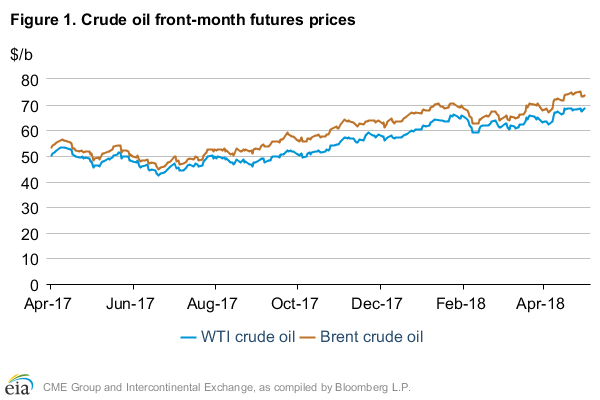The U.S. Energy Information Agency’s (EIA) May “Short-Term Energy Outlook’’ (STEO) predicted Brent crude oil prices would average $71 per barrel this year, $7 higher than what was forecast in April.
Correspondingly, EIA’s forecast for regular gasoline retail prices increased to an average of $2.79 per gallon this year, 15 cents higher that in April’s STEO. Monthly average Brent crude oil spot prices have increased in nine of the past 10 months, most recently averaging $72 per barrel in April.
EIA expects West Texas Intermediate (WTI) crude oil prices to average $5 per barrel lower than Brent prices this year. Even though WTI is a domestic crude benchmark and Brent is an international benchmark, gasoline prices in the United States tend to follow Brent.
In late April 2018, daily spot prices for Brent crude oil reached $76 per barrel, the highest level in nearly four years.
3 Reasons for Crude Oil Prices Rise
Crude oil prices have probably been driven higher for three reasons: falling global oil inventories, heightened market perceptions of geopolitical risks, and strong global economic growth signals.
EIA estimates that global oil inventories fell an average of nearly 600,000 barrels per day in each of the past five quarters. Oil inventories for countries within the Organization for Economic Cooperation and Development (OECD) at the end of April were an estimated 3 percent lower than the previous five-year average (2013–2017) in terms of days of supply, the largest percentage below the five-year average since March 2014.
Enjoying our insights?
Subscribe to our newsletter to keep up with the latest industry trends and developments.
Stay InformedSince the publication of the May STEO, the United States announced it would withdraw from the Joint Comprehensive Plan of Action with Iran. This news and resulting price movements are not reflected in the May STEO, issued May 8, but EIA will consider these developments when formulating the June STEO.
At the same time, global liquid fuels consumption is quickly increasing. EIA estimates global oil consumption-weighted gross domestic product (GDP) growth for this year will be at its highest rate since 2012. Greater GDP growth has the potential to increase oil consumption beyond forecasted levels, which could put upward pressure on crude oil prices, and simultaneously drive systemic market movements in equities, bonds and other commodities, which are often correlated with movements in crude oil prices.






















